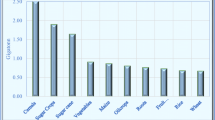Abstract
This study focused for the influence of temperature and duration of heat treatment applied to seed sludge on anaerobic biohydrogen fermentation. Temperature for the treatment varied from 90°C to 100°C, and duration from 15 and 180 min. The observed hydrogen production from the batch hydrogen fermentation was explained by the difference equation between cumulative hydrogen production and consumption, both of which are expressed by the modified Gompertz equations. The hydrogen production potential was effected by temperature and duration of heat treatment used for the anaerobic seed sludge. The maximum value of hydrogen production potential was 63.1 mL H2/g glucose, which was obtained from seed sludge treated at 100°C for 30 min. The compositions of volatile fatty acids in the products and their levels, as well as carbon dioxide content in the biogas, were also effected by temperature and duration of the heat treatment used for the anaerobic seed sludge, and they were important factors for determined the hydrogen production potential.
Similar content being viewed by others
References
American Public Health Association (APHA) (1995). “Standard methods for the examination of waste and wastewater.” 19th Ed., Washington D.C.: APHA, AWWA.
Aymard, C. and Belarbi, A. (2000). “Kinetics of thermal deactivation of enzymes: A simple three parameters phenomenological model can describe the decay of enzyme activity, irrespectively of the mechanism.” Enzyme Microb. Technol., Vol. 27, pp. 612–618.
Bolton, J. (1995). “The photochemical conversion and storage of solar energy: An historical perspective.” Solar Energy Materials and Solar Cells, Vol. 38, pp. 543–554.
Fan, Y., Li, C., and Lay, J. J. (2004). “Hou H., Zhang G., optimization of initial substrate and pH levels for germination of sporing hydrogen producing anaerobes in cow dung compost.” Biores. Technol., Vol. 91, pp. 198–193.
Fang, H. H. P. and Liu, H. (2002). “Effect of pH on hydrogen production from glucose by a mixed culture.” Biores Technol., Vol. 82, pp. 87–93.
Grommen, R., Verhaege, M., and Verstraete, W. (2006). “Removal of nitrate in aquaria by means of electrochemically generated hydrogen gas as electron donor for biological denitrification.” Aquacultural Engineerign, Vol. 34, pp. 33–39.
Han, S. K. and Shin, H. S. (2004). “Biohydrogen production by anaerobic fermentation of food waste.” Int. J. Hydrogen Energy, Vol. 29, pp. 569–577.
Hawkes, F. R., Dinsdale, R., Hawkes, D. L., and Hussy, I. (2002). “Sustainable fermentative hydrogen production: challenges for process optimization.” Int. J. Hydrogen Energy, Vol. 27, pp. 1339–1347.
Iyer, P., Bruns, M. A., Zhang, H., Ginkel, S. V., and Logan, B. E. (2004). “H2 producing bacterial communities from a heat treated soil inoculum.” Appl. Microbiol. Biotechnol., Vol. 66, pp. 166–173.
Jia, X. S., Furumai, H., and Fang, H. H. P. (1996). “Extracellular polymers of hydrogen utilizing methanogenic and sulfate reducing sludges.” Water Res., Vol. 30, No. 6, pp. 1493–1444.
Kapdan, I. K. and Kargi, F. (2006). “Bio-hydrogen production from waste materials.” Enzyme and Microbial. Technology, Vol. 38, pp. 569–582.
Kim, S. H., Han, S. K., and Shin, H. S. (2004). “Feasibility of biohydrogen production by anaerobic co-digestion of food waste and sewage sludge.” Int. J. Hydrogen Energy, Vol. 29, pp. 1607–1616.
Lay, J. J., Fan, K. S., Chang, J. I., and Ku, C. H. (2003). “Influence of chemical nature of organic wastes on their conversion to hydrogen by heat shock digested sludge.” Int. J. hydrogen energy, Vol. 28, pp. 1361–1367.
Levin, D. B., Pitt, L., and Love, M. (2004). “Biohydrogen production: prospects and limitations to practical application.” Int. J. Hydrogen Energy, Vol. 29, pp. 173–185.
Mukhopadhyay, K. and Forssell, O. (2005). “An empirical investigation of air pollution from fossil fuel combustion and its impact on health in India during 1973–1974 to 1996–1997.” Ecological Economics, Vol. 55, pp. 235–250.
Noike, T., Takabatake, H., Mizuno, O., and Ohba, M. (2002) “Inhibition of hydrogen fermentation of organic wastes by lactic acid bacteria.” Int. J. Hydro. Energy, Vol. 27, pp. 1367–1371.
Oh, S. E., Ginkel, S. V., and Logan, B. E. (2003) “The relative effectiveness of pH control and heat treatment for enhancing biohydrogen gas production.” Environ. Sci. Technol., Vol. 37, No. 22, pp. 5186–5190.
Park, W., Hyun, S. H., Logan, B. E., and Kim, I. S. (2005) “Removal of headspace CO2 increases biological hydrogen production.” Environ. Sci. Technol., Vol. 39. No. 12, pp. 4416–4420.
Author information
Authors and Affiliations
Corresponding author
Rights and permissions
About this article
Cite this article
Woo, JH., Song, YC. Influence of temperature and duration of heat treatment used for anaerobic seed sludge on biohydrogen fermentation. KSCE J Civ Eng 14, 141–147 (2010). https://doi.org/10.1007/s12205-010-0141-5
Received:
Revised:
Accepted:
Published:
Issue Date:
DOI: https://doi.org/10.1007/s12205-010-0141-5




